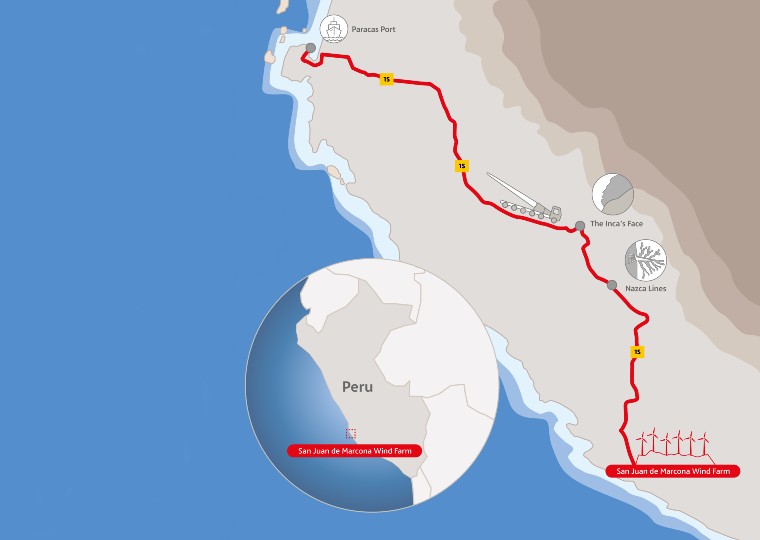-
Transporting the San Juan de Marcona wind farm components from the Peruvian port of Paracas to its site 150 miles south in the province of Nazca has been a veritable logistical feat. Read on to learn how we did it.
-
Moving 23 wind turbines across 150 miles is a colossal undertaking. It’s even more challenging when these towering structures, reaching an impressive height of 485 feet, need to traverse the arid Peruvian coastal desert. The journey is punctuated with obstacles, particularly along the Panamericana Sur highway, notorious for its six tight bends winding through the formidable mountains surrounding the Cara del Inca (Face of the Inca) pass. These rocky formations bear a striking resemblance to the aquiline nose profile, a characteristic feature of the ancient inhabitants of these lands and their leader, Atahualpa.
Covering a distance that would take an ordinary car about five hours, the transportation of large wind turbine components—nacelles, blades, and power trains—consumed three days for each turbine. Disassembled into 12 pieces, there were a staggering 276 transports in total, executed over three months.
-
This complex logistical operation was masterminded by a seasoned team of 150 experts, meticulously planning every detail. Their preparation involved constructing temporary bridges, clearing obstacles in populated zones, including traffic lights, electronic tolls, and route indicators, and implementing necessary traffic closures. The Peruvian National Police was integral to ensuring the operation’s success.
-
-
The entire operation unfolded between 6 a.m. and 6 p.m. each day, and upon its conclusion, it is worth celebrating that it was carried out without any significant incidents and according to the planned schedule. A triumph in both punctuality and execution.
Ariel Flores García, the project manager for PE San Juan de Marcona, proudly states, “We’ve successfully completed the component transfer without a hitch, despite the daily impact on local traffic, which is a source of pride for our entire team.”
-
"Covering a distance that would take a car five hours, the transportation of each turbine consumed three days".
-
-
The transportation of San Juan de Marcona wind turbine in figures
- Route: Port of Paracas - San Juan de Marcona wind farm (Peru)
- Distance: 150 miles
- Load: 23 wind turbines in 276 transports.
- Duration (large components): 3 days
- Total duration of transport: 3 months
- Highlights: Cara del Inca Pass and Nazca Lines.
- Territory:Peruvian coastal desert.
-

-
The enigma of the Nazca Lines
Another remarkable milestone on this journey was the passage through the Nazca Lines, not due to logistical complexity but because of the magnetic allure of this unique archaeological treasure intersected by the Pan-American Highway.
An astronomical calendar? A magical ritual to summon water? Extraterrestrial landing strips? The reasons behind the Nasca culture’s creation of hundreds of geoglyphs and enormous grooves on the ground of the Jumana plains, one of the planet’s driest regions 1,500 years ago, remain one of the greatest enigmas in world archaeology.
-
-
Designated a UNESCO World Heritage site in 1994, the Nazca Lines encompass hundreds of drawings spread across an area 31 miles long and 3.1 miles wide, primarily consisting of lines and geometric shapes. The most famous, however, include around thirty figures of animals (like the hummingbird, spider, monkey, whale, and condor), plants (such as the cactus and flower),, and anthropomorphic designs (like the man-bird or astronaut and hands), some stretching up to 613 feet in length.
Discovered by the Spanish conquistador Pedro Cieza de León in 1547, their modern archaeological interest began in the 1930s with Peruvians Julio César Tello and Toribio Mejía. American researcher Paul Kosok and German mathematician María Reiche, who dedicated decades to their study in the mid-20th century, concluded that they constituted a vast astronomical calendar linked to agricultural cycles, created from smaller-scale sketches.
Among more recent interpretations, American archaeologist Johan Reinhard argues that their purpose was to invoke water through fertility rituals.
-
Although the lines can be seen from various hills, the widespread belief that they are only visible from the air has given rise to less scientific and unsubstantiated interpretations. Swiss author Erich von Däniken, starting in 1968, sold thousands of copies of his works in which he considered them evidence of past extraterrestrial visits.
On a negative note, it’s worth mentioning that the lack of legal protection allowed the Pan-American Highway to split the El Lagarto figure in two in 1938.
-
-
A century making electricity from water
In many respects, it is a living museum. The beauty of its architecture, and the antiquated machinery sparkling within its halls, are a delight to behold. But a century after construction, Seira hydroelectric power station is still generating clean energy.
-
-
-
-





